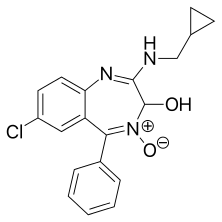 | |
 | |
| Clinical data | |
|---|---|
| Routes of administration | Oral |
| ATC code |
|
| Legal status | |
| Legal status |
|
| Pharmacokinetic data | |
| Metabolism | Hepatic |
| Excretion | Renal |
| Identifiers | |
IUPAC name
| |
| CAS Number | |
| PubChem CID | |
| ChemSpider | |
| UNII | |
| KEGG | |
| ChEMBL | |
| CompTox Dashboard (EPA) | |
| Chemical and physical data | |
| Formula | C19H18ClN3O |
| Molar mass | 339.82 g·mol−1 |
| 3D model (JSmol) | |
SMILES
| |
| |
| (verify) | |
Cyprazepam[1] is a drug which is a sedative-hypnotic benzodiazepine derivative.[2][3][4][5] It has anxiolytic properties,[6] and presumably also has hypnotic, skeletal muscle relaxant, anticonvulsant and amnestic properties.
Synthesis
The lactam moiety in benzodiazepams is active towards nucleophiles and numerous analogues have been made by exploiting this fact.

Cyprazepam synthesis:[7]
For example, heating demoxepam with N-cyclopropylmethylamine leads to amidine formation, the minor tranquilizer cyprazepam.
See also
References
- ^ US 3138586
- ^ Oelschläger H, Martienssen D, Belal F (22 September 2006). "Ring Contraction of 1,4-Benzodiazepines to 3,4-Dihydroquinazolines During Macro Scale Reduction (Example 5: Cyprazepam)". Archiv der Pharmazie. Wiley Interscience. 325 (8): 503–507. doi:10.1002/ardp.19923250810. ISSN 0365-6233. S2CID 96638676. Archived from the original on 5 January 2013.
- ^ EP 1466628, Matthews B, Victor S, Nigel, Swindell C, "DHA-pharmaceutical agent conjugates", published 13 October 2004
- ^ "Harmonized Tariff Schedule of the United States (2009) - Supplement 1 - PHARMACEUTICAL APPENDIX TO THE HARMONIZED TARIFF SCHEDULE" (PDF). USA: United States International Trade Commission. 2009. Archived from the original (PDF) on 31 July 2009. Retrieved 19 September 2009.
- ^ Schafer EW, Bowles WA, Hurlbut J (May 1983). "The acute oral toxicity, repellency, and hazard potential of 998 chemicals to one or more species of wild and domestic birds". Archives of Environmental Contamination and Toxicology. 12 (3): 355–82. doi:10.1007/BF01059413. PMID 6882015. S2CID 32956594.
- ^ World Health Organization (2006). "The use of stems in the selection of International Nonproprietary Names (INN) for pharmaceutical substances" (PDF). USA: Ministry of health, Syria. Retrieved 19 September 2009.
- ^ US 3138586, Wuest HM, published 1964; Chem. Abstr., 61: 7,032f (1964).